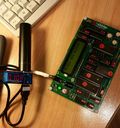 I you haven’t seen my previous posts on the Nibbler, have a look here for what happened so far.
I you haven’t seen my previous posts on the Nibbler, have a look here for what happened so far.
It’s a November evening which means it’s dark and cold outside and I’m looking out my windows to see a steady stream of car headlights. I’m glad I’m back home. Earlier today I’ve bought the missing chip for my Nibbler board and it’s time after all the effort put into understanding the concept and assembling the hardware if it will actually work. Adrenaline is flowing freely now, not only because my progress was slowed down by a pre-scheduled visit to the dentist. I was close to canceling it, I had a good enough ‘technical’ reason but it would have been that, just an excuse. So one dentist appointment later I finally sit at my desk and insert the remaining chip into the waiting socket on the Nibbler board. Once more I verify that all sockets contain the correct chip and come away satisfied.
Time for attaching the board to the power supply. If all goes well, “press any button” should show up on the display. I should have changed the text it into “hello world” but I decided to go ahead with a binary from the author rather than something written myself. More time for playing around with the software later, it’s a hardware thing today. I connect the board to my 5V battery I normally use for recharging my phone as I don’t even a regulated power supply. I intend to run it on a 5V USB mobile phone charger later but as I’m not quite sure the 5V delivered by a charger is flat enough for the Nibbler I decided on the battery instead.
I flip the master switch on the board and the green power supply LED turns on instantly – Apart from that – NOTHING happens on the display. What!?
Pressing the reset button a couple of times I refuse to believe that something could be seriously wrong. But the display remains dark. I then press the up/down/left/right keys and the piezo speaker starts making noises every time I press a button. Hope returns as the program I flashed into the ROM is supposed to do that. So the program must be running! Yay! But why is there nothing on the display, is the display or the output port chip broken? Then comes the flash of insight – I soldered a potentiometer onto the board to control the LCD module’s contrast. During the assembly phase I put it into a middle setting to ensure that I would at least see something when I first power-up the board. Perhaps a middle setting is not good enough? So I change the setting with a screwdriver first in one direction, resulting in nothing, then in the other direction and suddenly “press any button” shows up on the display. HURRAY – it’s only the contrast setting! As you can imagine, I’m overjoyed!
For the next half our I run a number of programs Steve Chamberlain has put together for the Nibbler, all in a single ROM and accessible via different jumper settings, a cool idea from William Bucholz, the creator of the PCB board. Everything works as it should. Wonderful! Now that the hardware is running I can further explore the hardware in ways that are just not possible with a simulator. But before that some sleep is in order to get the adrenaline from the dentist appointment and from those seconds between power-on and realizing that the contrast level has to be adjusted to see something on the display out of the system.
To be continued…